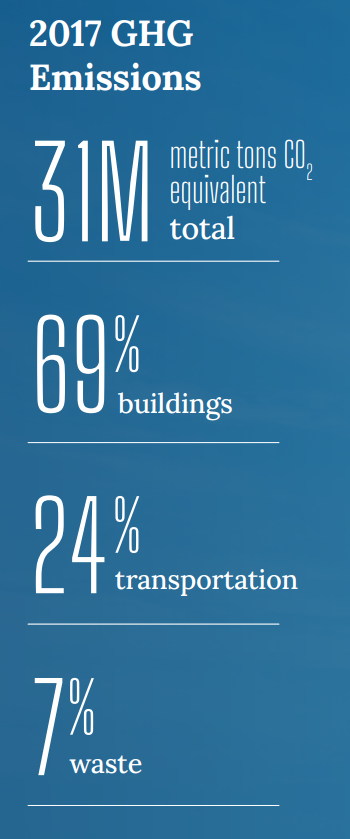Electrify Chicago
An independent tool for viewing City of Chicago building data
According to the
2022 Chicago Climate Action Plan,
69% of Chicago's emissions come from buildings, making
building emissions our biggest challenge and our biggest opportunity as a city
to tackle climate change. At Electrify Chicago, we showcase building performance using
publicly available data supplemented by community-submitted photographs and building
owners.
Start by looking at Chicago's buildings with the highest greenhouse gas intensity i.e. emissions per square foot. Large, efficient, buildings can perform much better than very inefficient small buildings on this metric.
New Article
📰 $30 Million In Missed Fines
The City Of Chicago failed to collect $30 million in potential fines from the building benchmarking ordinance, reducing transparency and accountability.
Legislative update! 🎉
As of late January 2024, legislation is being introduced to require new use more efficient forms of water and space heating, via the Clean And Affordable Buildings Ordinance (CABO), which will reduce the number of highly polluting and inefficient buildings that end up on this site.
If you're in Chicago,
write to your alderman to support the CABO!
Chicago Buildings by Greenhouse Gas Intensity
Note: Data includes large Chicago buildings with data from 2022, unless explicitly stated otherwise.
Note: This data only includes buildings whose emissions are reported
under the
Chicago Energy Benchmarking Ordinance. According to the City “As of 2016,
this list includes all commercial, institutional, and residential buildings larger than
50,000 square feet.” This dataset is also then filtered to only buildings with
reported emissions > 1,000 metric tons CO2 equivalent.
The latest year of data is from 2022, but we update the site regularly when new data is available, and some buildings may have failed to report that year, and only have older data available.
| Property Name / address | Primary Property Type |
Greenhouse Gas Intensity (kg CO2 eq./sqft) |
Total Greenhouse Emissions (metric tons CO2 eq.) |
|---|---|---|---|
|
Lincoln Park HS -CPS
(CPS)
2016 N Orchard St
| K-12 School | 5.2 kg/sqft
Lowest 28%
| 1,777 tons
Highest 26%
|
|
1225 Old Town
1225 N Wells St
| Multifamily Housing | 5.2 kg/sqft
Lowest 28%
| 2,261 tons
Highest 20%
|
|
The Bernardin
747 N Wabash Ave
| Multifamily Housing | 5.2 kg/sqft
Lowest 28%
| 1,712 tons
Highest 27%
|
|
Baumhart Hall-ID#160412
🕰️
(Loyola)
26 E Pearson St
| Residence Hall/Dormitory | 5.2 kg/sqft | 1,270 tons |
|
EnV Chicago
161 W Kinzie St
| Multifamily Housing | 5.2 kg/sqft
Lowest 28%
| 2,067 tons
Highest 22%
|
|
Rosenwald Courts
4643 S Wabash
| Multifamily Housing | 5.2 kg/sqft
Lowest 28%
| 1,117 tons
Highest 41%
|
|
451 W Wrightwood Ave
451 W Wrightwood Ave
| Multifamily Housing | 5.2 kg/sqft
Lowest 28%
| 600 tons
Lowest 33%
|
|
Michigan Avenue Lofts
910 S Michigan Ave
| Multifamily Housing | 5.2 kg/sqft
Lowest 28%
| 2,707 tons
Highest 16%
|
|
5236 5252 S HYDE PARK BLVD
5236 5252 S HYDE PARK BLVD
| Multifamily Housing | 5.2 kg/sqft
Lowest 28%
| 717 tons
Lowest 41%
|
|
2800 North Orchard Condominium Association
2800 N Orchard St
| Multifamily Housing | 5.2 kg/sqft
Lowest 28%
| 496 tons
Lowest 26%
|
|
The Regal
🕰️
651 S WELLS ST
| Multifamily Housing | 5.2 kg/sqft | 517 tons |
|
Lowes Home Improvement
7971 S CICERO AVE
| Wholesale Club/Supercenter | 5.2 kg/sqft
Lowest 28%
| 701 tons
Lowest 40%
|
|
Trinity Acres
3939 S CALUMET AVE
| Multifamily Housing | 5.2 kg/sqft
Lowest 28%
| 267 tons
Lowest 6%
|
|
LaSalle Private Residences
1212 N LaSalle St
| Multifamily Housing | 5.2 kg/sqft
Lowest 28%
| 1,900 tons
Highest 24%
|
|
4940 S EASTEND AVE
4940 S EASTEND AVE
| Multifamily Housing | 5.2 kg/sqft
Lowest 28%
| 771 tons
Lowest 44%
|
Data Source:
Chicago Energy Benchmarking Data
